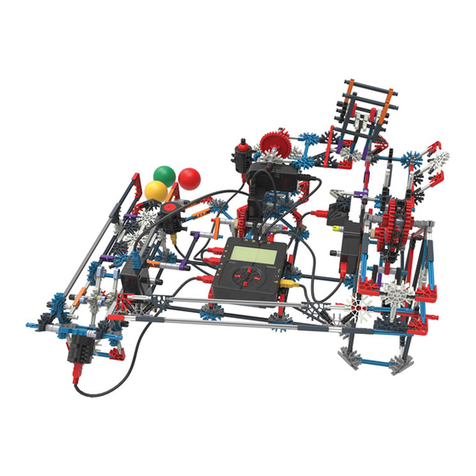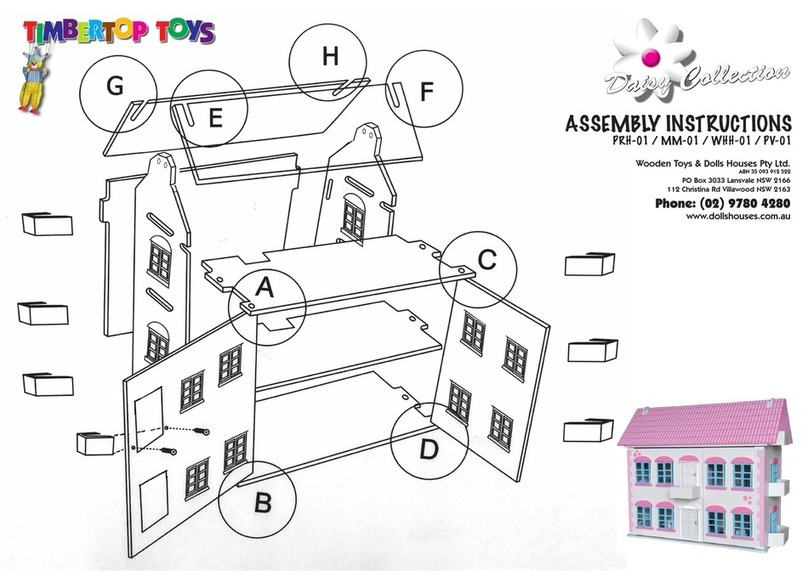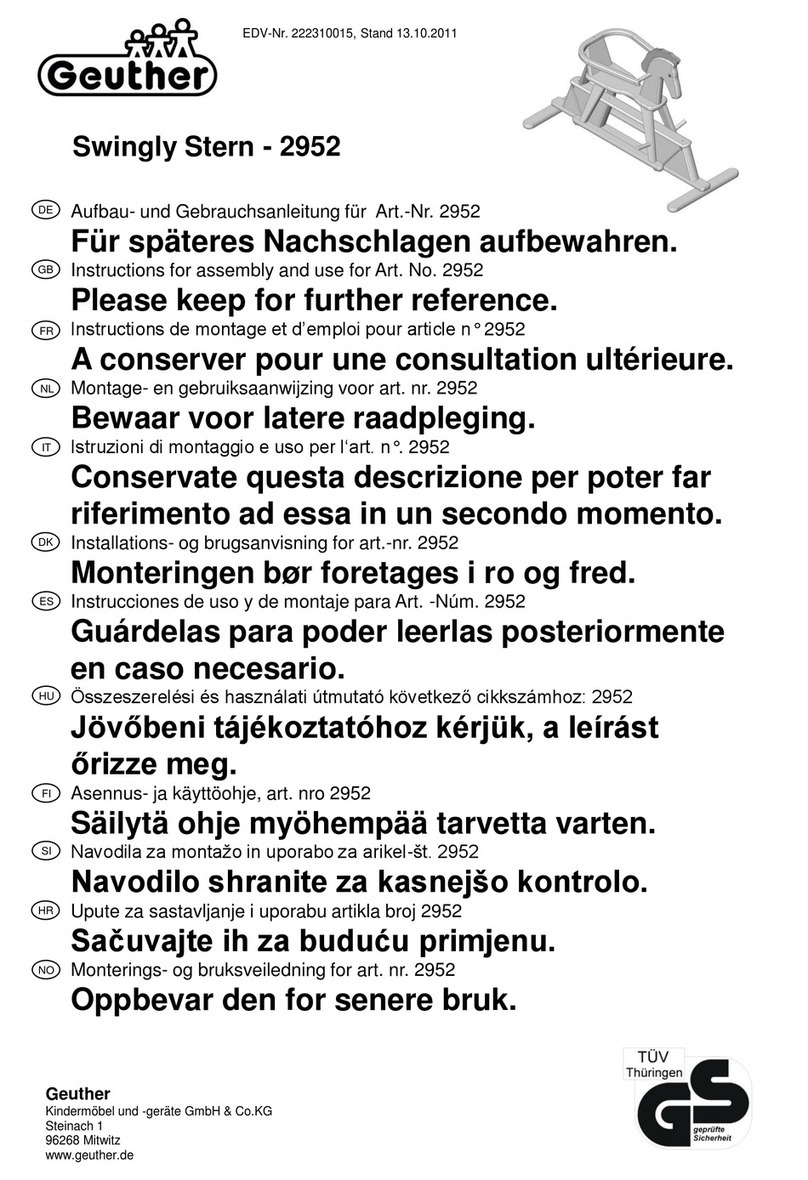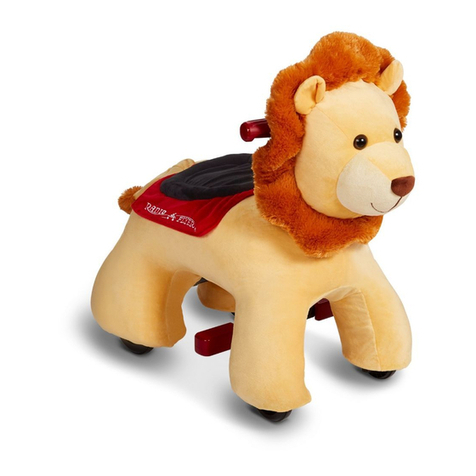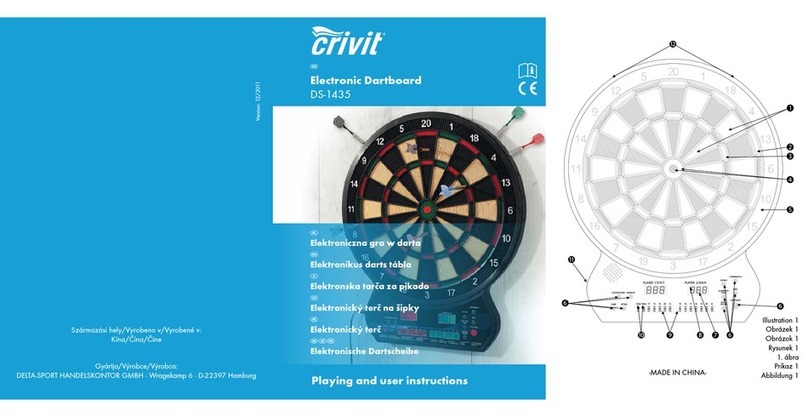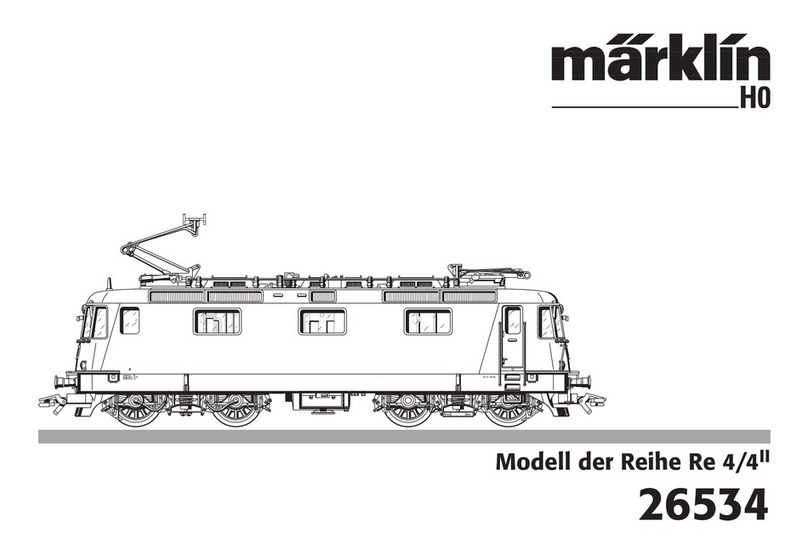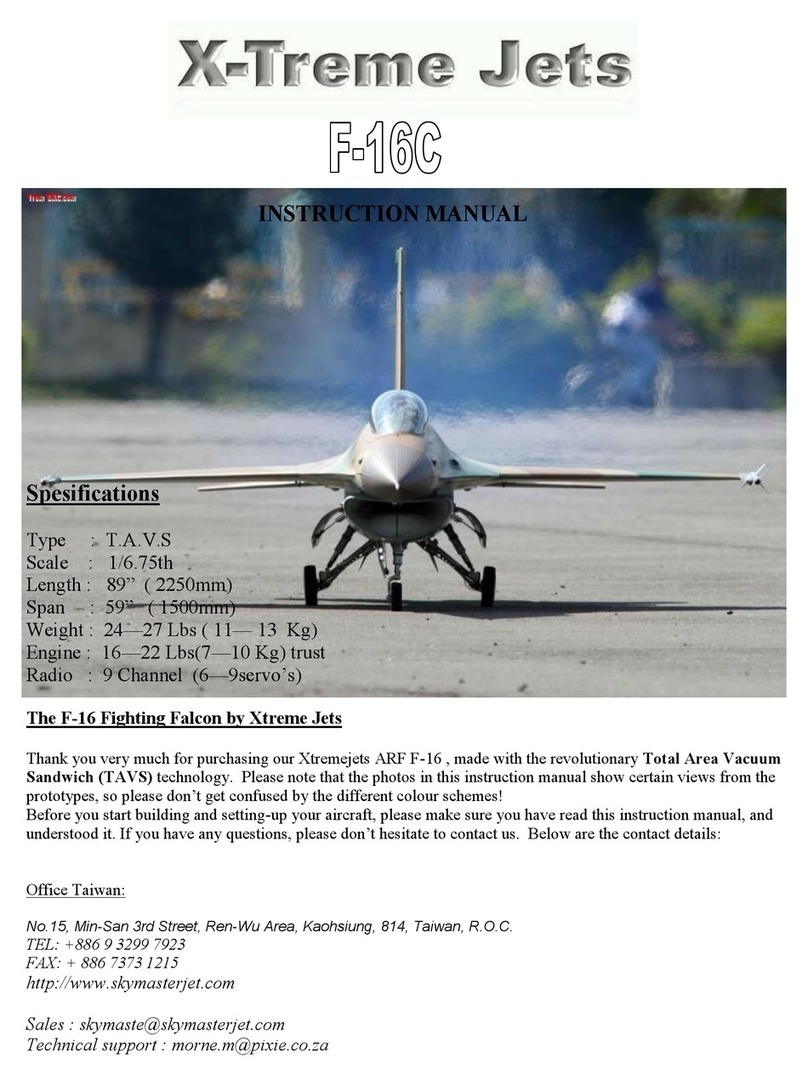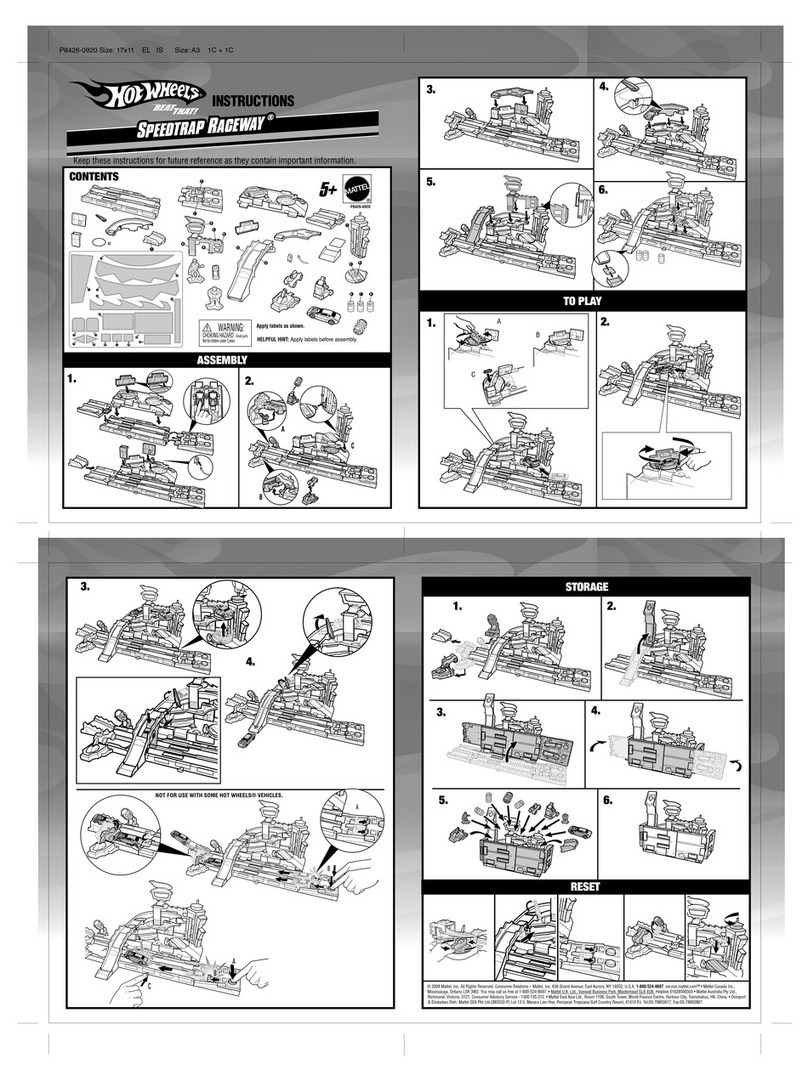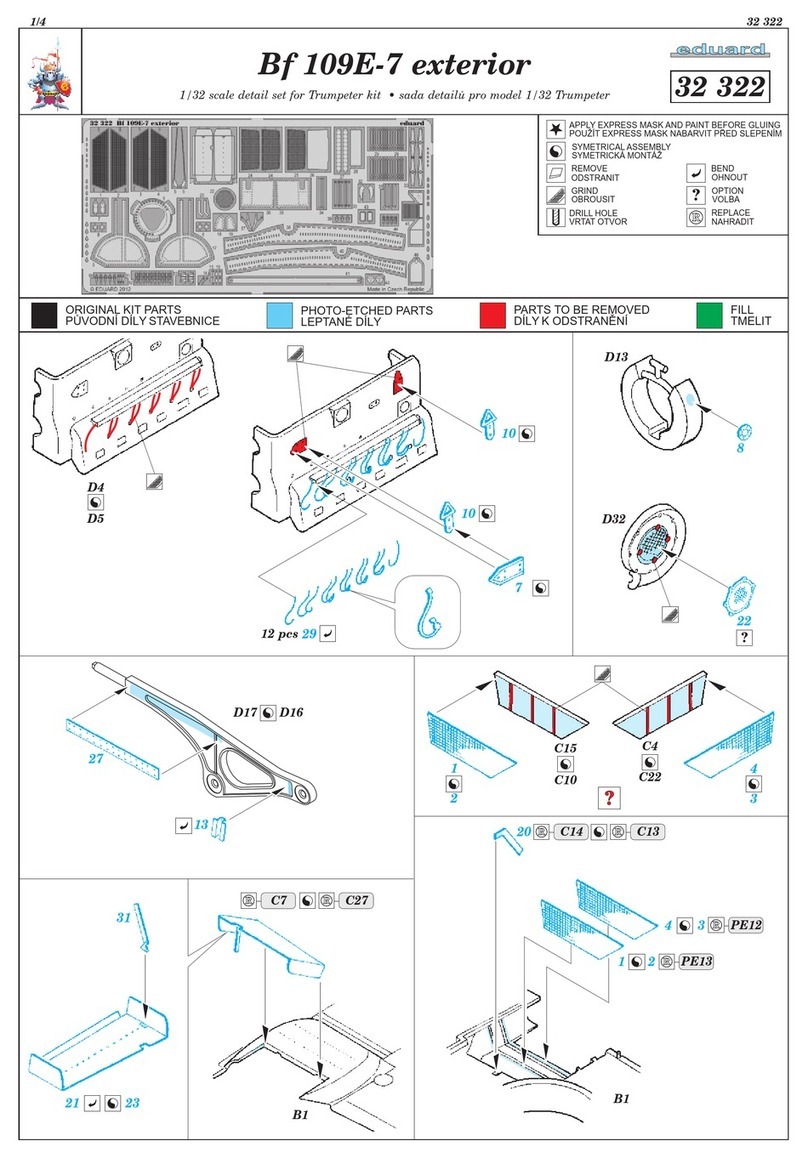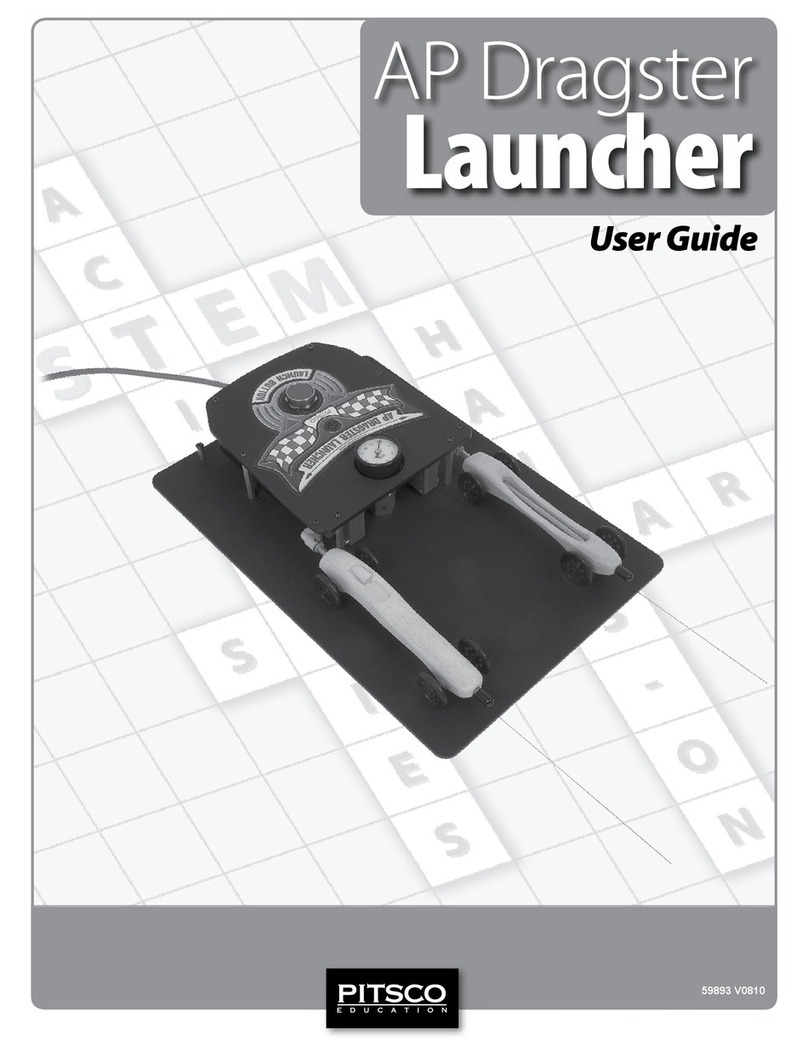TF TOP FLITE P-470 THUNDERBOLT User manual

READ THROUGH THIS MANUAL BEFORE STARTING CONSTRUCTION. IT CONTAINS IMPORTANT INSTRUCTIONS AND WARNINGS CONCERNING THE ASSEMBLY AND USE OF THIS MODEL.
Entire Contents © Copyright 2008 Printed in U.S.A. TOPA0955Mnl V1.0
WARRANTY
Top Flite Models guarantees this kit to be free from defects in both material and workmanship at the date of
purchase. This warranty does not cover any component parts damaged by use or modification. In no case
shall Top Flite’s liability exceed the original cost of the purchased kit. Further, Top Flite reserves the
right to change or modify this warranty without notice.
In that Top Flite has no control over the final assembly or material used for final assembly, no liability shall be
assumed nor accepted for any damage resulting from the use by the user of the final user-assembled prod-
uct. By the act of using the user-assembled product, the user accepts all resulting liability.
If the buyer is not prepared to accept the liability associated with the use of this product, the buyer is
advised to return this kit immediately in new and unused condition to the place of purchase.
To make a warranty claim send the
defective part or item to Hobby
Services at this address:
Include a letter stating your name, return shipping address, as much contact information as possible (daytime
telephone number, fax number, e-mail address), a detailed description of the problem and a photocopy of the
purchase receipt. Upon receipt of the package the problem will be evaluated as quickly as possible.
Hobby Services
3002 N. Apollo Dr. Suite 1
Champaign IL 61822 USA
SPECIFICATIONS
™
Wingspan: 63 in
[1600mm]
Wing
Area:
730 sq in
[46.5 dm2]
Weight: 9.5 –10.5 lb
[3970 – 4540 g]
Wing
Loading:
30 – 33 oz/sq ft
[91–101 g/dm2]
Length: 56 in
[1420mm]
Radio: 6+ channel with 8 servos
Engine: .60 –.91 cu in
[10 –15cc] two-stroke,
.90 –1.20 cu in
[15 – 20cc] four-stroke

2
TABLE OF CONTENTS
INTRODUCTION ..........................2
AMA ..................................2
SAFETY PRECAUTIONS ...................2
DECISIONS YOU MUST MAKE...............3
Radio Equipment ........................3
Engine Recommendations.................3
Landing Gear Options ....................3
Scale Competition .......................4
ADDITIONAL ITEMS REQUIRED .............4
Hardware and Accessories ................4
Adhesives and Building Supplies............4
Optional Supplies and Tools ...............4
IMPORTANT BUILDING NOTES ..............4
KIT INSPECTION..........................5
KIT CONTENTS...........................5
ORDERING REPLACEMENT PARTS ..........6
PREPARATIONS ..........................6
ASSEMBLE THE WING .....................6
Mount the Servos........................6
Install the Aileron and Flap Pushrods ........8
Join the Wing Panels .....................9
Install the Retractable Landing Gear,
Servo, Wheels and Gear Doors ..........10
Optional Pneumatic Retracts ..............10
Finish the Wing ........................14
ASSEMBLE THE FUSELAGE ...............15
Install the Horizontal Stabilizer,
Elevators and Rudder .................15
Install the Servos, Engine and Fuel Tank.....17
Install the Tail Wheel and Linkages .........19
Install the Radio System .................20
FINISH THE MODEL ......................22
Install the Cowl & Dummy Engine ..........22
Install the Scale Details ..................24
Install the Cockpit Interior, Pilot and Canopy ..25
Install the Propeller and Spinner ...........26
Apply the Decals .......................27
GET THE MODEL READY TO FLY ...........27
Check the Control Directions ..............27
Set the Control Throws ..................27
Balance the Model (C.G.) ................28
Balance the Model Laterally...............28
PREFLIGHT .............................28
Identify Your Model......................28
Charge the Batteries ....................29
Balance Propellers......................29
Ground Check .........................29
Range Check ..........................29
ENGINE SAFETY PRECAUTIONS ...........29
AMA SAFETY CODE......................30
General ..............................30
Radio Control..........................30
CHECK LIST ............................30
FLYING.................................31
Fuel Mixture Adjustments ................31
Takeoff ...............................31
Flight ................................31
Landing ..............................32
INTRODUCTION
Following the great success of the Top Flite P-47
.60-sized kit comes the same beautiful model in
ARF form! The sky is the limit for the amount of
additional detail that could be added during the
building process to make the P-47 a model even the
most serious scale-minded builder could appreciate.
The model assembles in as little as 15-20 hours, with
time consuming painting tasks expertly complete out
of the box.
For the latest technical updates or manual corrections
to the P-47 ARF, visit the Top Flite web site at www.
top-flite.com. Open the “Airplanes” link, then select
the P-47 ARF. If there is new technical information or
changes to this model, a “tech notice” box will appear
in the upper left corner of the page.
AMA
We urge you to join the AMA (Academy of Model
Aeronautics) and a local R/C club. The AMA is the
governing body of model aviation and membership
is required to fly at AMA clubs. Though joining the
AMA provides many benefits, one of the primary
reasons to join is liability protection. Coverage is
not limited to flying at contests or on the club field. It
even applies to flying at public demonstrations and
air shows. Failure to comply with the Safety Code
(excerpts printed in the back of the manual) may
endanger insurance coverage. Additionally, training
programs and instructors are available at AMA club
sites to help you get started the right way. There are
over 2,500 AMA chartered clubs across the country.
Contact the AMA at the address or toll-free phone
number below:
Academy of Model Aeronautics
5151 East Memorial Drive
Muncie, IN 47302-9252
Tele. (800) 435-9262
Fax (765) 741-0057
Or via the Internet at:
http://www.modelaircraft.org
IMPORTANT!!! Two of the most important things
you can do to preserve the radio controlled aircraft
hobby are to avoid flying near full-scale aircraft and
avoid flying near or over groups of people.
PROTECT YOUR MODEL,
YOURSELF & OTHERS...
FOLLOW THESE IMPORTANT
SAFETY PRECAUTIONS
1.Your P-47 ARF should not be considered a toy, but
rather a sophisticated, working model that functions
very much like a full-size airplane. Because of its
performance capabilities, the P-47, if not assembled
and operated correctly, could possibly cause injury to
yourself or spectators and damage to property.
2. You must assemble the model according to the
instructions. Do not alter or modify the model, as
doing so may result in an unsafe or unflyable model.
In a few cases the instructions may differ slightly from
the photos. In those instances the written instructions
should be considered as correct.

3
3. You must take time to build straight, true
and strong.
4. You must use an R/C radio system that is in first-
class condition, and a correctly sized engine and
components (fuel tank, wheels, etc.) throughout the
building process.
5. You must correctly install all R/C and other
components so that the model operates correctly on
the ground and in the air.
6. You must check the operation of the model
before every flight to insure that all equipment
is operating and that the model has remained
structurally sound. Be sure to check clevises or
other connectors often and replace them if they
show any signs of wear or fatigue.
7. If you are not an experienced pilot or have not
flown this type of model before, we recommend that
you get the assistance of an experienced pilot in your
R/C club for your first flights. If you’re not a member
of a club, your local hobby shop has information
about clubs in your area whose membership includes
experienced pilots.
8. While this kit has been flight tested to exceed
normal use, if the plane will be used for extremely
high stress flying, such as racing, or if an engine
larger than one in the recommended range is used,
the modeler is responsible for taking steps to reinforce
the high stress points and/or substituting hardware
more suitable for the increased stress.
We, as the kit manufacturer, provide you
with a top quality, thoroughly tested kit and
instructions, but ultimately the quality and
flyability of your finished model depends on how
you build it; therefore, we cannot in any way
guarantee the performance of your completed
model, and no representations are expressed
or implied as to the performance or safety of
your completed model.
Remember: Take your time and follow the
instructions to end up with a well-built model that is
straight and true.
Before starting to build, compare the parts in this
model with the Parts List and note any missing
parts. Also inspect all parts to make sure they are of
acceptable quality. If any parts are missing, broken or
defective, or if you have any questions about building
or flying this airplane, please contact Top Flite at the
address or telephone number below. If requesting
replacement parts, please provide the full model
name (P-47 ARF) and the part numbers as listed in
the Parts List.
Top Flite Product Support
3002 N Apollo Drive Suite 1
Champaign, IL 61822
Telephone: (217) 398-8970
Fax: (217) 398-7721
E-mail: productsupport@top-flite.com
DECISIONS YOU MUST MAKE
This is a partial list of items required to finish the P-47
ARF that may require planning or decision making
before starting to build. Order numbers are provided
in parentheses.
RADIO EQUIPMENT
A 6-channel radio system such as a Futaba®6EXAS
with a standard receiver and seven standard size
servos with a minimum torque of 50 oz-in [3.6 kg-cm]
are required for the control surfaces of the P-47 ARF.
When installing the included mechanical retracts,
a 180 degree retract servo will also be required. If
you will be installing optional Robart pneumatic
retracts, a micro servo will be required to operate
the air valve. One standard torque servo such as an
S3003 is required for the throttle. Two 24" [610mm]
servo extensions (aileron servos), three 6" [152mm]
servo extensions (aileron, flap and landing gear) and
two Y-harnesses (aileron and flap servos) are also
required. A receiver battery pack with a minimum
capacity of 1000mAh is recommended. Order
numbers are provided below:
oFutaba S9001 Servo Aircraft Coreless BB
(FUTM0075)
oFutaba S136G Compact Retract Servo
(FUTM0670)
o
Futaba S3115 Micro Precision Servo (FUTM0415)
oFutaba S3003 Servo Standard (FUTM0031)
o
Hobbico®Extension 24" Futaba J (HCAM2200)
oHobbico Extension 6" Futaba J (HCAM2000)
oFutaba 6" Dual Servo Extension J (FUTM4130)
oFutaba NR4RB Receiver NiCd 4.8V 1000mAh
J (FUTM1380)
ENGINE RECOMMENDATIONS
A .60-.91 cu in [10-15cc] two-stroke or .90-1.20 [15-
20cc] four-stroke engine is required. An O.S.®FS-91
Surpass™II four-stroke engine installation is shown
in this manual.
oO.S. FS-91 II Surpass (OSMG0896)
oO.S. .61 FX ABL (OSMG0561)
LANDING GEAR OPTIONS
The P-47 ARF includes mechanical retracts.
Optional pneumatic retracts can also be installed.
Part numbers are provided below:
oRobart 605HD 90 Degree Mains w/3/16" Wire
(ROBQ0005)
oRobart 188VR Standard Air Control Kit
(ROBQ2302)
oRobart 190 Air Line Quick Disconnects
(ROBQ2395)
SCALE COMPETITION
Though the Top Flite P-47 ARF may not have the
same level of detail as an “all-out” scratch-built
competition model, it is a scale model nonetheless
and is therefore eligible to compete in the Fun Scale
class in AMA competition (we receive many favorable
reports of Top Flite models in scale competition!).

4
To receive the five points for scale documentation,
the only proof required that a full size aircraft of this
type in your paint/markings scheme did exist is a
single sheet such as a kit box cover from a plastic
model, a photo, or a profile painting, etc. If the photo
is in black and white other written documentation of
color must be provided. Contact the AMA for a rule
book with full details.
If you would like photos of the full-size P-47 for scale
documentation, or if you would like to study the
photos to add more scale details, photo packs are
available from:
Bob’s Aircraft Phone: (714) 979-8058
Documentation Fax: (714) 979-7279
3114 Yukon Ave
Costa Mesa, CA 92626 www.bobsairdoc.com
ADDITIONAL ITEMS REQUIRED
HARDWARE AND ACCESSORIES
In addition to the items listed in the “Decisions You
Must Make” section, following is the list of hardware
and accessories required to finish the P-47 ARF.
Order numbers are provided in parentheses.
oR/C foam rubber (1/4" [6mm] - HCAQ1000, or
1/2" [13mm] - HCAQ1050)
o3' [900mm] standard silicone fuel tubing
(GPMQ4131)
ADHESIVES AND BUILDING SUPPLIES
In addition to common household tools (screw drivers,
drill, etc.), this is the “short list” of the most important
items required to build the P-47 ARF. We recommend
Great Planes Pro™CA and Epoxy glue.
o1/2 oz. [15g] Thin Pro CA (GPMR6001)
o1/2 oz. [15g] Medium Pro CA+ (GPMR6007)
oPro 6-minute epoxy (GPMR6045)
oPro 30-minute epoxy (GPMR6047)
oDrill bits: 1/16" [1.6mm], 5/64" [2mm], 3/32"
[2.4mm], 3/16" [4.8mm]
o8-32 tap and drill set (GPMR8103)
oGreat Planes Pro Threadlocker (GPMR6060)
o#1 Hobby knife (HCAR0105)
o#11 blades (5-pack, HCAR0211)
oMedium T-pins (100, HCAR5150)
oMasking tape (TOPR8018)
oDenatured alcohol (for epoxy clean up)
oPanel Line Pen (TOPQ2510)
o220-grit sandpaper
oPetroleum jelly or oil
o4 oz. J&Z R/C-56 Glue (JOZR5007)
OPTIONAL SUPPLIES AND TOOLS
Here is a list of optional tools mentioned in the manual
that will help you build the P-47 ARF.
o21st Century
®
sealing iron (COVR2700)
o21st Century iron cover (COVR2702)
o21st Century trim seal iron (COVR2750)
o1/2 oz. [15g] Thick Pro CA- (GPMR6013)
oSmall metal file
oStick-on segmented lead weights (GPMQ4485)
o2 oz. [57g] spray CA activator (GPMR6035)
o4 oz. [113g] aerosol CA activator (GPMR6034)
oCA applicator tips (HCAR3780)
oCA debonder (GPMR6039)
oEpoxy brushes 6, (GPMR8060)
oMixing sticks (GPMR8055)
oMixing cups (GPMR8056)
oPliers with wire cutter (HCAR0630)
oCompressed Air 10 oz (TAEC1060)
oMicroballoons (TOPR1090)
oErnst Charge Receptacle Futaba J (ERNM3001)
oRotary tool such as Dremel
oRotary tool reinforced cut-off wheel (GPMR8020)
oServo horn drill (HCAR0698)
oHobby Heat™micro torch (HCAR0750)
oDead Center™Engine Mount Hole Locator
(GPMR8130)
oAccuThrow™Deflection Gauge (GPMR2405)
oCG Machine™(GPMR2400)
oPrecision Magnetic Prop Balancer (TOPQ5700)
oHobbico Flexible 18" Ruler Stainless Steel
(HCAR0460)
oHobbico Pin Vise 1/16 Collet w/6 Bits
(HCAR0696)
oHobbico 8-Piece Ball Tip Hex L Wrench SAE
(HCAR0520)
oHobbico 7-Piece Ball Tip Hex L Wrench Metric
(HCAR0521)
oGreat Planes Precision Prop Reamer Standard
(GPMQ5006)
oGreat Planes Precision Prop Reamer Metric
(GPMQ5007)
oGreat Planes Clevis Installation Tool
(GPMR8030)
oX-Acto Extra Hands Double Clip (XACR4214)
IMPORTANT BUILDING NOTES
•There are two types of screws used in this kit:
Sheet metal screws are
designated by a number
and a length. For example
#6 x 3/4" [19mm]. This is a number
six screw that is
3/4" [19mm] long.
Machine screws are
designated by a number,
threads per inch, and a
length. For example 4-40 x
3/4" [19mm].
This is a number
four screw that is
3/4" [19mm] long
with forty threads
per inch.
•When you see the term test fit in the instructions,
it means that you should first position the part on
the assembly without using any glue, then slightly
modify or custom fit the part as necessary for the
best fit.

5
•Whenever the term glue is written you should
rely upon your experience to decide what type
of glue to use. When a specific type of adhesive
works best for that step, the instructions will make
a recommendation.
•Whenever just epoxy is specified you may use
either 30-minute (or 45-minute) epoxy or 6-minute
epoxy. When 30-minute epoxy is specified it is highly
recommended that you use only 30-minute (or
45-minute) epoxy, because you will need the working
time and/or the additional strength.
•Photos and sketches are placed before the
step they refer to. Frequently you can study
photos in following steps to get another view of
the same parts.
KIT INSPECTION
Before starting to build, take an inventory of this kit
to make sure it is complete, and inspect the parts
to make sure they are of acceptable quality. If any
parts are missing or are not of acceptable quality, or if
you need assistance with assembly, contact Product
Support. When reporting defective or missing parts,
use the part names exactly as they are written in the
Kit Contents list.
Top Flite Product Support
3002 N Apollo Drive, Suite 1
Champaign, IL 61822
Telephone: (217) 398-8970, ext. 5
Fax: (217) 398-7721
E-mail: airsupport@top-flite.com
1 - Fuselage
2 - Left and right wing panel
3 - Stabilizer with left and right elevator
4 - Rudder
5 - Cowl
6 - Belly pan
7 - Canopy
8 - Cockpit components
9 - Retractable landing gear and axle
10 - Wheels
11 - Landing gear doors
12 - Fuel tank
13 - Dummy engine
14 - Tail wheel
15 - Tail wheel cover
16 - Lower scoop
17 - Side scoops
18 - Forward scoops
19 - Spinner
20 - Engine mount
21 - Elevator joiner wire
22 - Machine guns
KIT CONTENTS
1
6
2
4
9
10
11
12
13
14
16
15
17
18
19 20
21
22
8
7
3
5
2
9
10
11
18
22

6
ORDERING
REPLACEMENT PARTS
Replacement parts for the Top Flite P-47 ARF are
available using the order numbers in the Replacement
Parts List that follows. The fastest, most economical
service can be provided by your hobby dealer or mail-
order company.
To locate a hobby dealer, visit the Hobbico web site
at www.hobbico.com. Choose “Where to Buy” at
the bottom of the menu on the left side of the page.
Follow the instructions provided on the page to locate
a U.S., Canadian or International dealer. If a hobby
shop is not available, replacement parts may also be
ordered from Tower Hobbies
®
at www.towerhobbies.
com, or by calling toll free (800) 637-6050.
Parts may also be ordered directly from Hobby
Services by calling (217) 398-0007, or via facsimile
at (217) 398-7721, but full retail prices and shipping
and handling charges will apply. Illinois and Nevada
residents will also be charged sales tax. If ordering
via fax, include a Visa
®
or MasterCard
®
number and
expiration date for payment.
Mail parts orders and
payments by personal
check to:
Hobby Services
3002 N Apollo Dr., Suite 1
Champaign IL 61822
Be certain to specify the order number exactly as
listed in the Replacement Parts List. Payment by
credit card or personal check only; no C.O.D.
If additional assistance is required for any reason
contact Product Support by e-mail at
productsupport@top-flite.com,
or by telephone at (217) 398-8970.
PREPARATIONS
o 1. If you have not done so already, remove the
major parts of the kit from the box and inspect for
damage. If any parts are damaged or missing, contact
Product Support at the address or telephone number
listed in the Kit Inspection section on page 5.
o 2. Use a covering iron with a covering sock on
high heat to tighten the covering if necessary. Apply
pressure over sheeted areas to thoroughly bond the
covering to the wood.
ASSEMBLE THE WING
MOUNT THE SERVOS
Before completing this section, confirm that the
servos that you will be using will properly fit between
the servo mounting block locations on the aileron
and flap servo hatch covers. Make adjustments
as necessary for your brand of servos. The block
locations shown in this section will fit a standard size
Futaba brand servo.
Order
Number Description
REPLACEMENT PARTS LIST
How to
purchase
Instruction manual
Missing pieces
Full-size plans
Wing Set
T/F P-47 ARF
TOPA1782
Fuselage
T/F P-47 ARF
TOPA1783
Tail Set
T/F P-47 ARF
TOPA1784
Cowl
T/F P-47 ARF
TOPA1785
Canopy
T/F P-47 ARF
TOPA1786
Decals
T/F P-47 ARF
TOPA1787
Dummy Engine
T/F P-47 ARF
TOPA1788
Wire Landing
Gear Set
T/F P-47 ARF
TOPA1789
Spinner
T/F P-47 ARF
TOPA1790
Gear Doors
T/F P-47 ARF
TOPA1791
Belly Pan
T/F P-47 ARF
TOPA1792
Contact
Product
Support
Not available
Contact
your
hobby
supplier
to
purchase
these
items

7
o o 1. Remove the tape holding the aileron and flap
covers to the wing. The servo mounting blocks are
pre-attached to the covers. To assure the blocks have
been adequately glued, apply a few drops of thin CA
to each of the blocks.
o o 2. Cut three arms from a four-armed servo arm
included with the aileron servo. Enlarge the outer hole
of the remaining arm with a 5/64" [2mm] drill bit.
o o 3. Attach a 24" [610mm] servo extension to
each aileron servo and secure the connector using
tape or heat shrink tubing (not included). Center the
servos with your radio system and install the servo
arm to the servo perpendicular to the servo case as
shown. Be sure to reinstall the servo arm screw into
the servo.
o o 4. Position the servo against the underside of
the aileron servo hatch cover between the mounting
blocks.Drill 1/16" [1.6mm] holes through the mounting
tabs on the servo case into the blocks. Insert and
then remove a servo mounting screw (included with
the servo) into each hole. Apply a drop of thin CA
to each hole to harden the wood. When the CA has
dried, install the servo onto the hatch cover using the
hardware supplied with the servo.
o o 5. Tie the string taped inside the aileron servo
hatches to the servo lead. The opposite end of the
string is taped to the wing's root rib. Pull the servo
lead through the wing ribs.
o o 6. Insert and then remove a #2 x 3/8"
[9.5mm] self-tapping screw into each hatch
mounting hole. Apply a drop of thin CA to each
hole to harden the wood. Once the glue has dried,
install the aileron hatch cover to the wing as
shown using four #2 x 3/8" [9.5mm] self-tapping
screws and four #2 flat washers.

8
o o 7. Mount the flap servo and hatch cover in the
same way. The flap servo does not require a servo
lead extension.
o o 8. Insert the servo leads through the hole in the
top of the wing. Tape the leads to the wing to prevent
them from dropping back in.
o 9. Repeat steps 1-9 for the left wing panel. Make
note that the flap servo arm will be mounted on the
root rib side of the right wing panel and the flap
servo arm is mounted towards the wing tip on the
left wing panel. When the flap servos are joined
together using a Y-harness, they will both move in
the same direction.
INSTALL THE AILERON
AND FLAP PUSHRODS
Refer to the photograph as you complete steps 1-4.
o o 1. Thread a nylon clevis 20 complete turns onto
a 4" [152mm] pushrod. Slide a silicone clevis retainer
onto the clevis and connect the clevis to the outer
hole of a nylon control horn.
o o 2. Position the control horn over the plywood
plate in the aileron (if you cannot see it, hold the aileron
at a shallow angle in good lighting or use a small pin
to puncture the covering) using the position of the
servo arm as a guide. Align the holes in the control
horn directly over the aileron hinge line and mark the
location of the control horn mounting holes.
o o 3. Drill 1/16" [1.6mm] holes at the marks you
made through the plywood plate. Do not drill all
the way through the aileron! Thread a #2 x 3/8"
[9.5mm] self-tapping screw through each hole and
back it out. Apply a couple drops of thin CA glue to
each hole to harden the wood. When the glue has
dried, install the control horns onto the aileron using
two #2 x 3/8" [9.5mm] self-tapping screws.
o o 4. Use tape or a small clamp to hold the aileron
in the neutral position. Make a mark on the pushrod
where it crosses the outer hole in the servo arm.
Make a 90 degree bend at the mark on the pushrod

9
and cut off the excess pushrod 1/4" [6mm] beyond
the bend. Attach the pushrod to the servo arm using
a nylon FasLink. Thread the clevis up or down on the
pushrod as necessary to center the aileron with the
servo arm centered. Slide the silicone clevis retainer
to the end of the clevis to secure it.
o o 5. Install the flap pushrod using the same
procedure used for the aileron. The flap pushrod is
installed in the same manner except the control horn
is mounted as shown in the photograph, and rather
than centering the servo arm, position the servo arm
so that it is angled back towards the trailing edge of
the wing.
o 6. Repeat steps 1-5 for the other wing panel.
JOIN THE WING PANELS
o 1. Locate the nylon anti-rotation pin. Epoxy it
into the hole in the right wing panel. Approximately
½"[13mm] of the pin should extend from the wing
o 2. Locate the hardwood wing joiner. The joiner
has a double taper. The photo shows how to identify
the top of the joiner and the front of the joiner. Test fit
the joiner into the joiner pocket of each wing panel.
The joiner should be able to fit halfway into each
pocket and be slightly loose to allow room for epoxy.
Sand the joiner as necessary for the proper fit.
o 3. Dry fit the wing panels together using the joiner.
The root ribs of the panels should sit flat against each
other with no gaps. Lightly sand the face of the root
ribs if necessary to eliminate any gaps between the
wing panels.
o 4. When satisfied with the fit of the wing panels
mix up a ½ ounce of 30-minute epoxy and coat the
inside of the wing joiner pockets in each wing panel.
Coat one half of the wing joiner and slide it into one
wing panel. Coat the root ribs of both wing panels
as well as the exposed ends of the joiner and anti-
rotation pin. Join the two wing panels together and
use paper towels dampened with denatured alcohol
to wipe away any excess epoxy from the joint
between the panels. Use masking tape to hold the
panels together tightly. Set the wing aside and let
the epoxy cure undisturbed.

10
o 5. Glue two nylon pins into the holes in the leading
edge, at the center of the wing. Approximately
½"[13mm] should extend from the leading edge of
the wing.
INSTALL THE RETRACTABLE LANDING
GEAR, SERVO, WHEELS AND GEAR DOORS
Optional Pneumatic Retracts
Some modelers may wish to install pneumatic
retractsinsteadofthemechanicalretractsincluded
in this kit. Mounting locations are provided in the
fuselage for optional pneumatic retract hardware
including the air tank, air valve, and air valve
servo. Tabs are designed into the air tank that
support the front of the air tank for securing it with
rubber bands. Detailed installation instructions
are not provided for installing pneumatic retracts.
However, the installation process for the gear is
similar to the mechanical installation shown in
the following instructions. The mechanical retract
pushrods will need to be replaced with air lines.
Be sure to follow the instructions included with
the pneumatic retract kit.
o 1. Locate the 3 plywood parts that make up the
servo tray. Test fit them into the center of the wing.
Adjust the parts as needed. Once you are satisfied
with the fit, glue the components in place.You will find
it easiest to glue each of the components in place
individually rather than gluing it together and then
trying to fit it into the opening.
2. Install your retract servo between the mounting rail
in the wing center section using the hardware that
came with the servo. Be sure to harden the screw
holes with thin CA glue.

11
o o 3. Remove the set screw from each side of the
landing gear. Apply a couple of drops of thread locker
onto the set screws. Then re-insert it and tighten it
against the landing gear wire. Do this for both gear.
o o 4. Position the landing gear onto the landing
gear rails as shown here. With a pencil or fine tip
marker, mark the location of the holes for mounting
the landing gear.
o o 5. On the marks you made for the location of
the landing gear drill a 7/64" [2.8mm] hole through
the rails. Insert and remove a #6 x3/4" [19mm] screw
into each of the holes. Apply a couple drops of thin
CA into the holes to harden the threads. Allow the
glue to harden.
o o 6. Locate one of the 12" [305mm] wires with the
“Z” bend on the end. Insert the end with the “Z” bend
into the connector on the end of the retract unit.
o o 7. Insert the wire from the landing gear into the
tube located in the wheel well. Using the tube as a
guide, push the wire into the wing until the landing
gear can rest on the landing gear rails.
o o 8. Mount the landing gear to the rail with four
#6 x ¾" [19mm] screws and four #6 flat washers.
o o 9. Apply a drop of thread locker to two 3mm
set screws. Then, thread them into the axle (the set
screws may already be installed in the axle. If so
remove them, apply thread locker, and then re-install
them into the axle). Slide the axle onto the landing
gear. Tighten the set screws in the axle against the flat
spots that have been cut into the end of the landing
gear. When the axle is properly installed, the end of
the axle will fit into the wheel well as shown.

12
o o 10. Using a motor tool or file, grind a flat spot
on the end of the axle.
o o 11. Install the wheel onto the axle. Apply thread
locker to the set screw and tighten the set screw
against the flat spot on the axle.
o o 12. Apply a piece of masking tape to the surface
of the wing at each end of the landing gear. You need
to transfer the exact center line of the landing gear to
the tape. Draw a line on the tape that is directly down
the center of the landing gear wire.
o o 13. Tape the landing gear door onto the landing
gear. Be sure to center the door in the opening,
leaving an equal spacing between the door and the
opening on both the leading edge and trailing edge
of the door.
o o 14. Apply another piece of masking tape to
the door in line with the landing gear wire. Using the
lines you previously drew at each end of the landing
gear, draw a line on the tape you just applied to the
door. This line represents the center of the landing
gear wire. From the center of the axle measure up
2-1/8" [54mm] and draw a line perpendicular to
the line representing the landing gear wire. From
that line measure up another 2" [51mm] and make
another line.

13
o o 15. Place one of the nylon humped landing
gear straps on the line you have drawn. Pay careful
attention, positioning it so the hump is centered on
the line representing the landing gear wire and the
mounting holes are on the crossing line.When you are
satisfied with the position, mark the hole locations
of the strap onto the line. Do this for both lines you
have drawn.
o o 16. On each of the four marks drill a
3/32"[2.5mm] hole through the landing gear door.
o o 17. Attach the door to the landing gear wire
with two humped landing gear straps, four 2-56 x 3/8"
[10mm] screws and four #2 nuts. Be sure to apply
thread locker to the screws. You may wish to apply a
drop of paint to the screw heads to make them blend
into the door.
o 18. Repeat steps 3-17 for the left wing.
o 19. Cut four arms from a six-arm servo arm,
leaving two arms opposite each other. Attach a brass
screw-lock connector to each arm in the outer hole
using a nylon retainer to secure them. Loosely thread
a 4-40 x 1/8" [3.2mm] SHCS into each screw-lock
connector. Bend the retract wire as shown to allow
the wire to be aligned with the hole in the brass screw
lock connector.Slide the retract pushrod wires through
the screw-lock connectors and press the arm onto the
servo spline in the orientation shown. With the retract
pushrods all the way in the retracted position, tighten
the SHCS in the screw-lock connectors against the
pushrods. Remember to apply a drop of threadlocker
to the SHCS. Test the operation of the landing gear
with your radio system. Confirm that the servo does
not bind and that the landing gear fully raise and
lower to the locked positions. Make any adjustments
necessary with the screw-lock connectors and servo
arm position. When satisfied, secure the servo arm
to the servo using the servo arm screw included with
the servo.

14
FINISH THE WING
o 1. Locate the fiberglass belly pan. Sand the
painted edge with 220-grit sandpaper and clean the
surface with alcohol.
o 2. Temporarily install the wing onto the fuselage
using two 1/4-20 nylon wing bolts. The wing dowels
will fit into receiving holes in the former at the leading
edge of the wing. Align the fiberglass belly pan onto
the underside of the wing in line with the fuselage
and tape it into position. Use a felt-tip pen to trace
around the belly pan onto the wing. Remove the belly
pan and trim a 3/8" [10mm] strip of covering from the
underside of the wing just inside the line you drew.
Be careful to cut only the covering and not the
surface of the wing. Use a sharp hobby knife or the
“ Hot Tip” that follows.
HOW TO CUT COVERING FROM BALSA
Use a soldering iron to cut the covering from the
stab. The tip of the soldering iron doesn’t have to
be sharp, but a fine tip does work best. Allow the
iron to heat fully. Use a straightedge to guide the
soldering iron at a rate that will just melt the cov-
ering and not burn into the wood. The hotter the
soldering iron, the faster it must travel to melt a
fine cut. Peel off the covering.
o 3. Glue the belly pan to the wing with epoxy. Tape
the belly pan in place and put some weight on it to
hold it in place while the glue dries.
o 4. There are two sets of black tubes that will be
installed as machine guns in the leading edge of the
wing. The holes for the guns are pre-drilled to the
correct depth for each of the guns. The tubes are
installed so the longest gun is towards the center of
the wing and the shortest is towards the tip. Test fit
a tube into each of the holes. Once you are satisfied
with the fit, glue the machine guns into the holes in
the leading edge of the wing.
Built in greater quantities than any other US fighter,
the P-47 was the heaviest single-engine WWII
fighter to go into production and the first piston-
powered fighter to exceed 500 mph. The Thunderbolt
performed 546,000 combat sorties between March
of 1943 and August 1945 and is considered the real
forerunner of today’s multirole fighters.

15
ASSEMBLE THE FUSELAGE
INSTALL THE HORIZONTAL STABILIZER,
ELEVATORS AND RUDDER
For the installation of the stabilizer you will need
to have rubbing alcohol on hand for clean up.
If you do not have any, DO NOT START THIS
INSTALLATION UNTIL YOU DO!
It is suggested that you read the next few steps
to better understand the process before actually
gluing components in place.
o 1. Temporarily attach the wing to the fuselage with
two ¼ - 20 nylon wing bolts. Slide the horizontal
stabilizer in place in the back of the fuselage.Position
the stab so that it is equal in length on both sides of
the fuselage and that the distance from the wing tip
to the stabilizer tip is equal.
o 2. When you are satisfied with the positioning,
mark the outline of the fuselage onto the top and the
bottom of the stabilizer with a fine point felt-tip pen.
o 3. Inside of the line you have marked, cut the
covering from the top and bottom of the stabilizer
using the same technique used on the bottom of the
wing. Make sure you cut the covering only!
o 4. Locate the elevator joiner wire, and insert it
into the slots in the stab opening. Then insert the stab
into the opening in the rear of the fuselage.
o 5. Stand back a few feet and look at the stab in
relation to the wing. The stab should be parallel and
in line with the wing. If you find that your stab is not
aligned, adjust the stab by removing small amounts
of the stab saddle with 100 grit sand-paper.
o 6. Move the stab to the right and left, exposing the
wood where you cut the covering away.Apply 30-minute
epoxy to the wood on both the top and bottom of the
stab. Work the glue into the stab opening by moving
the stab back and forth.When you are satisfied with the
penetration of the glue, clean away the excess epoxy
from the stab and fuselage using a cloth dampened
with alcohol. Once cleaned, double check the stab
position and check to be sure the elevator joiner wire
moves freely. Set it aside to cure.

16
o 7. Cut the included CA hinge material into six 3/4"
x 1" [19mm x 25mm] individual hinges. Use a hobby
knife or scissors to trim the corners from each hinge
to make them easier to insert into the hinge slots.
o 8. Drill a 3/32" [2.4mm] hole 1/2" [13mm] deep in
the center of each hinge slot in the wing panel and
aileron. Use a sharp hobby knife to carefully cut away
the covering just around each hinge slot.
o 9. Insert three hinges into each elevator. If the
hinges don’t remain centered, stick a pin through the
middle of the hinge to hold it in position. Slide the
hinges into the elevator, sliding the joiner wire into the
hole in the elevator. Once you are satisfied everything
fits, remove the elevator.
o 10. Apply a small amount of epoxy into the hole in
each elevator half. Re-install the elevators and hinges
to the stab. Remove any pins you may have inserted
into the hinges. Adjust the elevator so there is a small
gap between the LE of the elevator and the stab. The
gap should be small, just enough to see light through
or to slip a piece of paper through. Apply six drops of
thin CA to the top and bottom of each hinge. Do not
use CA accelerator. After the CA has fully hardened,
test the hinges by pulling on the elevator. Do this for
both elevator halves.

17
o 11. Install three hinges into the rudder the same
as done with the elevator. Test fit the rudder to the
fin. When you are satisfied with the final fit, apply six
drops of thin CA to the top and bottom of each hinge.
o 12. Screw a nylon clevis onto a .074 x 36"
[914mm] threaded wire 20 turns. Slide a nylon clevis
retainer onto the clevis. Slide the pushrod wire into
the pushrod guide tube hole on the right side of the
fuselage. Install the clevis into the outer hole of the
control horn. Then, slide the silicone retainer over
the clevis. Mark the location for the control horn
onto the elevator. Drill a 1/16" [1.6mm] hole into the
plywood plate in the elevator. Do not drill through
the elevator. Screw the horn to the rudder with #2 x
3/8" [10mm] screws. Remove the screws, and apply
a drop of thin CA to harden the threads. After the glue
has dried, re-install the screws into the horn.
o 13. Repeat step 14 for the rudder. The pushrod
wire will slide into the pushrod guide tube on the left
side of the fuselage.
INSTALL THE SERVOS, ENGINE
AND FUEL TANK
We will be showing the installation of the O.S. .91
engine. If you are installing a larger four-stroke
engine or a two stroke engine, you may need to
make additional cut outs in the cowl or the fuselage
to accommodate the cylinder head and the muffler.
o 1. Use the wire pushrods as your guide for
positioning the servos. Cut three arms from a four-
armed servo arm. Center the servo with your radio
system and install the servo arm perpendicular to
the servo case as shown. Install the servos using the
same procedure used for the other servos, mounting
them onto the servo rails. Be sure to harden the screw
holes with thin CA.
o 2. Bolt the engine mount to the firewall with
four 8-32 x 1" [25mm] socket head cap screw, #8
lock washer and #8 flat washer. The engine will be
mounted inverted so be sure the mount is attached to
the firewall inverted. Place your engine on the mount
and adjust the mounting rail position to match and
then tighten the bolts.
o 3. Position the engine on the mount so the
distance from the firewall to the front of the thrust
washer measures 6-1/8" [155mm]. Mark the location

18
of the engine on the mount. The Great Planes®“Dead
Center” Hole Locator (GPMR8130) works well for
this. Drill through the marks you have made with a
#29 or 9/64" [3.6mm] drill bit. Tap each hole with an
8-32 tap.
o 4. Before installing the engine to the mount, check
the location of the throttle arm. Looking from the back
of the engine, the arm needs to be on the left side.
The O.S. engines allow you to rotate the carburetor.
Remove the two screws holding the carburetor to the
engine. Remove the carburetor, rotate it 180 degrees,
and then re-install the screws. Engines other than O.S.
may or may not allow you to rotate the carburetor. If
you cannot, you will have to position the throttle servo
in a different location than you will be instructed later
in this manual.
o 5. Install the engine to the mount with four each,
8-32 x 1" [25mm] socket head cap screws, #8 lock
washers and #8 flat washers.
o 6. Install a brass screw lock connector to the outer
hole of the throttle arm. Lock it to the arm with a nylon
retainer. Slide a pushrod wire through the connector,
touching it to the firewall. Make a mark where the wire
will pass through the firewall.
o 7. Drill a 3/16" [4.8mm] hole on the mark. Glue a
12" [305mm] plastic tube into the hole.
o 8. Remove the servo arm from the rudder. Install
a ball link into the second hole from the center. Lock
it to the servo horn with the 0-80 nut. Re-install the
horn to the servo.
o 9. Slide the wire from the throttle into the brass
screw lock connector. Lock the wire to the connector
with a 4-40 x 1/8" [3mm] socket head cap screw. For
the rudder and elevator, center the control surfaces.
Make a mark on the pushrod where it crosses the
outer hole in the servo arm. Make a 90 degree bend
at the mark on the pushrod and cut off the excess
pushrod 1/4" [6mm] beyond the bend. Attach the
pushrod to the servo arm using a nylon FasLink.
Make sure all of the servo horn screws are installed
in the servos.
o 10. Bend the throttle pushrod slightly to get a
smooth movement of the pushrod wire and then
secure the wire with a 4-40 x 1/8" [3mm] socket head
cap screw. Be sure to apply threadlocker to the bolt.
Remove screws to
rotate carburetor
Correct position
for throttle arm

19
o 11. Assemble the fuel tank as shown in the
sketch. When tightening the center screw be sure not
to over tighten it. You just want it snug enough to pull
the rubber stopper tight against the tank.
o 12. Slide the neck of the fuel tank into the hole in
the firewall and rest the tank on the tray. Secure the
tank to the tray with two #64 rubber bands.
o 13. Install silicone fuel tubing (not supplied) onto
the aluminum tubes from the fuel tank. One line with
the fuel clunk will feed to the fuel inlet at the needle
valve. The second line with the fuel clunk will be the
line to fill the tank and the other will attach to the
pressure tap on the muffler. (The muffler will not be
installed at this time. You will do this while fitting the
cowl.) The fill line should be plugged after fueling with
the aluminum fuel plug provided with the kit.
INSTALL THE TAIL WHEEL AND LINKAGES
o 1. Locate the pieces for the tail wheel assembly.
Loosely thread the 3x5mm SHCS into the collar
hole in the steering arm. Slide the steering arm onto
the tail wheel wire and tighten the SHCS against
the flat spot in the wire. Be sure that the steering
arm is oriented in the same direction as shown in
the picture. Slide the nylon support onto the wire
beneath the steering arm. Tighten a 1/8" [3.2mm]
wheel collar using a 4-40 set screw onto the wire
below the nylon support. The support should still be
able to rotate on the wire. Secure a brass screw-
lock connector to the linkage hole in the steering
arm with a nylon retainer. Loosely thread a 4-40
set screw into the screw-lock connector. Be sure to
apply thread locker to all of the screws.
o 2. Secure the assembly with two #2 x 3/8" [9.5mm]
self-tapping screws.

20
o 3. Thread a nylon ball cup onto the end of a 2-56
x 36" [914mm] pushrod threaded on one end. Cut
the wire to a length of 27-3/4" [705mm]. Insert the
pushrod into the pushrod tube that is closest to the
bottom of the fuse. Feed the aft end of the pushrod
through the brass screw lock connector on the tail
wire steering arm and out the elevator control horn
access hole. Push the ball cup onto the ball stud.
o 4. Center the tail wheel wire axle and tighten the
set screw in the screw-lock connector against the tail
wheel pushrod.
o 5. Fit the tail wheel hatch cover in place and
secure it with four #2 x 3/8" [9.5mm] screws. Be sure
to harden the screw holes with thin CA.
o 6. Install the tail wheel onto the tail wheel axle
using two 1/8" [3.2mm] wheel collars and two 4-40
set screws. Be sure that the wheel rotates on the axle
freely. Oil the axle if necessary.
INSTALL THE RADIO SYSTEM
o 1. Locate the plywood battery / receiver tray.
Loop one of the Velcro straps through the slots in the
ends of the tray. Place a piece of foam between the
tray and your receiver battery. Secure the battery to
the tray with the Velcro.
o 2. Slide the remaining Velcro through the other two
slots in the tray, wrapping them around the top.
Table of contents
Popular Toy manuals by other brands
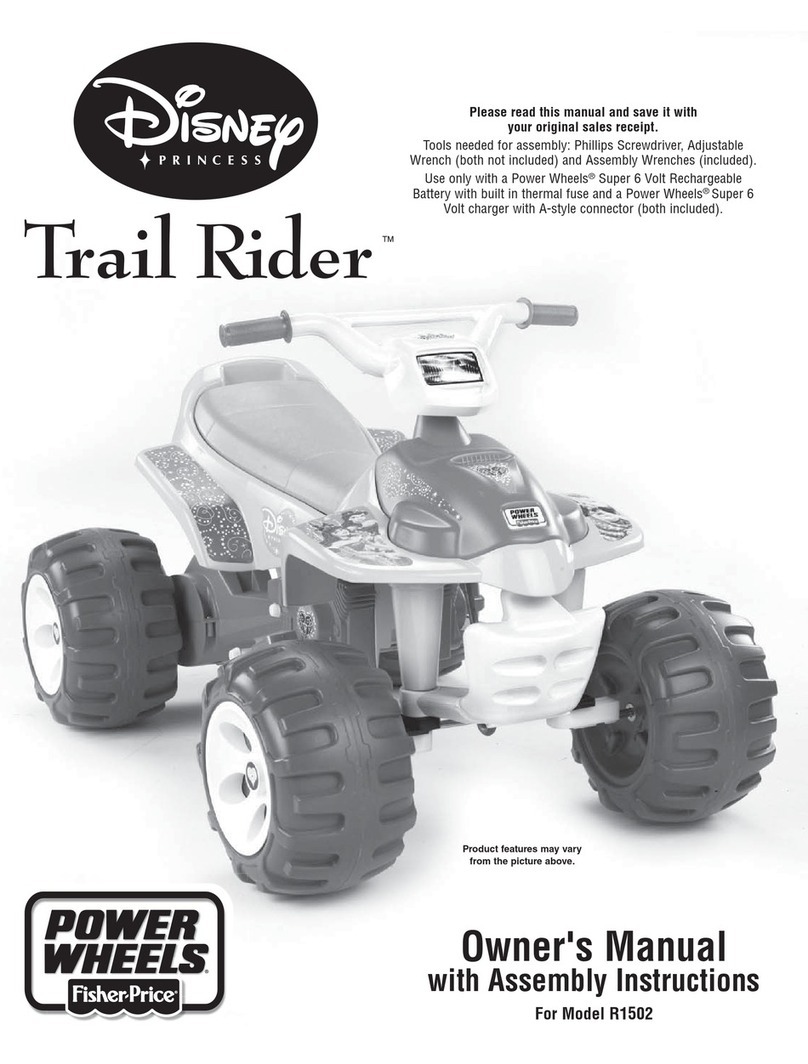
Fisher-Price
Fisher-Price TRAIL RAIDER R1502 Owner's manual & assembly instructions

Tamiya
Tamiya Volkswagen Beetle 58383 Assembly manual
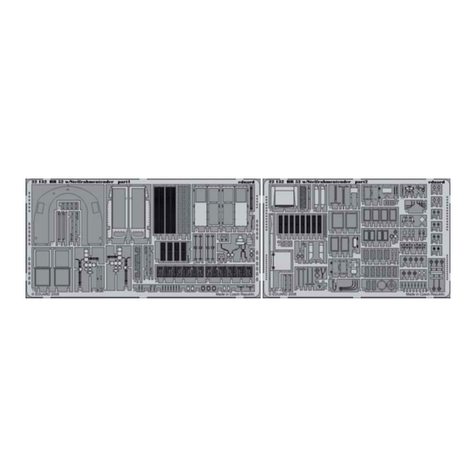
Eduard
Eduard BR 52 w/Steifrahmentender exterior quick start guide

Mattel
Mattel Polly Pocket Designables Mix 'n match mall instructions
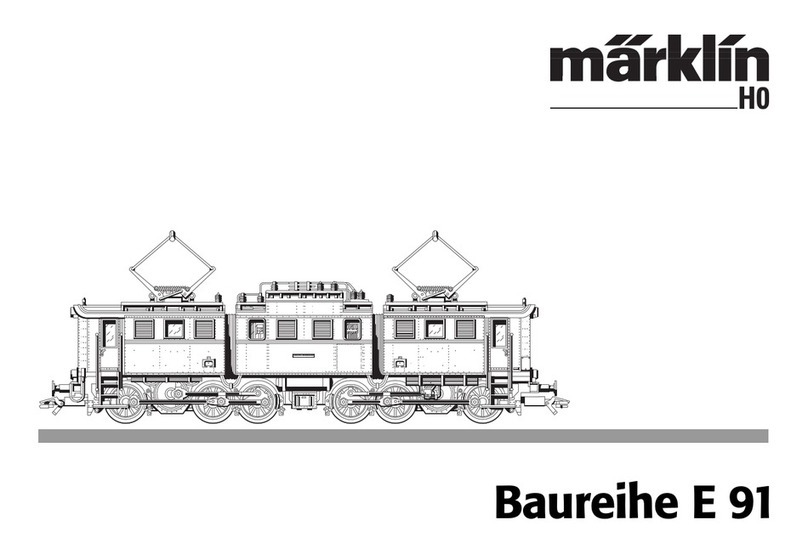
marklin
marklin baureihe E 91 user manual
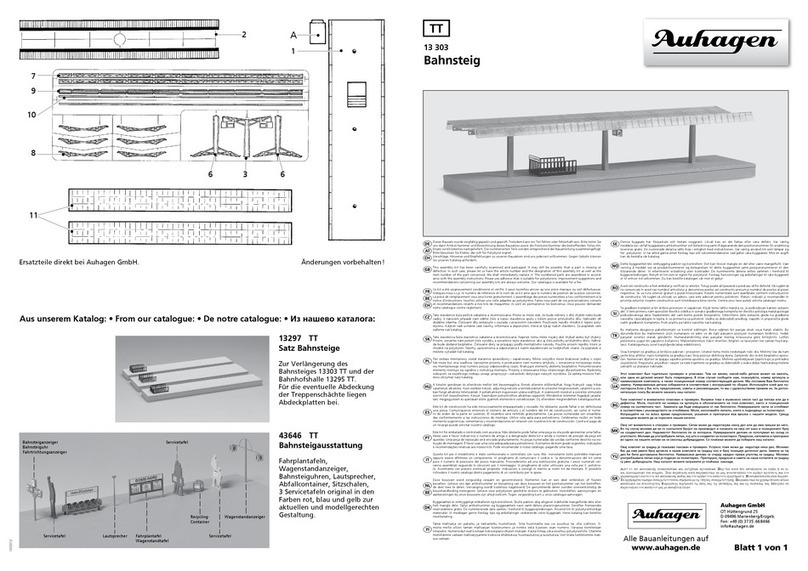
Auhagen
Auhagen 13 303 manual
